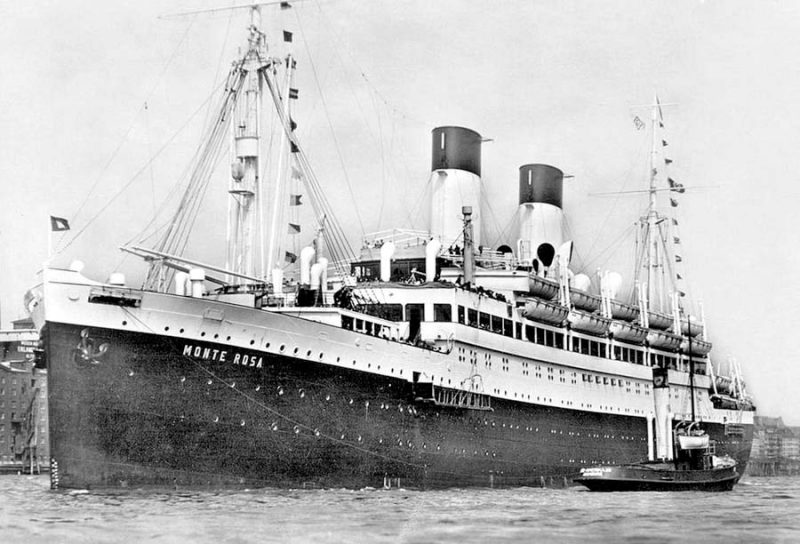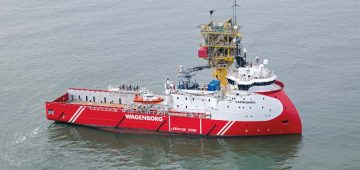Immigrant Ship and Trooper
This famous twin funnelled troopship is well remembered for her voyage from the Caribbean to Tilbury in June 1948 with 492 immigrants, plus several stowaways, who were seeking work in London as the first post war Caribbean immigrants. The massive movement of immigration into Britain over the last seventy years has seen the word ‘Windrush’ enter the English language as an example of the new multi-cultural society and citizenship of Britain and what it today means to be ‘British’. In 1998, an area of public open space in Brixton, London, was renamed Windrush Square to commemorate the 50th anniversary of the arrival of the Empire Windrush’s West Indian passengers. Ten years later, a blue Thurrock Heritage plaque was unveiled at the London Cruise Terminal in Tilbury, and in 2018 we celebrate the 70th anniversary of her arrival with British Caribbean immigrants as an established and familiar part of the British way of life.
Monte Rosa
Empire Windrush started life a world away from this as the last of a quintet of ‘Monte’ passenger and cruise ships for the Hamburg Süd America Line, formed in 1871 and the most famous of the European shipping lines serving South America. Monte Rosa of 13,882 grt wore the white funnels and red tops of Hamburg Sud and a proud red and white quartered houseflag flying from her foremast with the letters ‘H S D G’ in black in the quarters. Monte Rosa was launched on 4th December 1930 as Yard number 492 at the famous Hamburg shipyard of Blohm & Voss, which had also completed her four earlier sisters Monte Olivia (1924), Monte Sarmiento (1925), Monte Cervantes (1927), Monte Pascoal (1930), and with Monte Rosa completed in 1931.
Monte Rosa had dimensions of length 500.3 feet (152.48 metres), moulded beam of 65.7 feet (19.99 metres), depth of 37.8 feet (11.48 metres) and loaded draft of 26.7 feet. She had five continuous decks in her hull including the uppermost continuous deck (‘C’ Deck), and above that were the passenger accommodation and public rooms of Promenade Deck (‘B’ Deck), Boat Deck (‘A’ Deck) and the Navigating Bridge Deck in her ‘midships accommodation of length 299.0 feet. The quintet of ‘Monte’ passenger liners were diesel powered by a quartet of M.A.N. six cylinder four stroke single acting diesel engines single reduction geared to twin screw shafts by the shipbuilder, each of 6,800 bhp and a total of 27,200 bhp, to give a service speed of 14.5 knots. This speed was considered adequate for the South American service and for cruising, but was only half of the speed of the express steam turbine powered liners employed on the busy North Atlantic route. The steam powered auxiliary deck equipment used steam raised from twin cylindrical Scotch type boilers in the boiler room.
Monte Rosa had accommodation for 2,408 passengers, with half of this number in Second Class in the better staterooms of the ‘midships accommodation, and half in the lower decks for Third Class, which in fact was dormitory accommodation for steerage passengers. She had two sets of Dining Rooms and Main Lounges and smaller public rooms, with the Second Class of course being a lot grander and with the addition of a Verandah Cafe at the aft end of Promenade Deck. The public rooms and Second Class staterooms were beautifully panelled in various woods on top of two inches of fireproof material. She carried a crew of 253, and had cargo space in her holds for 406,000 cubic feet of dry cargo, and 5,600 cubic feet of refrigerated cargo, to give a deadweight tonnage of 10,896 tonnes.

The hull of Monte Rosa had eight watertight bulkheads extending to ‘D’ Deck, with the collision bulkhead reaching up a deck higher than the others. She had a foremast, mainmast and cruiser stern with several derricks on each mast and sets of posts, 28 lifeboats in total in banked pairs, and her navigating bridge had the latest of navigation equipment including wireless direction finders and submarine signalling apparatus, with every deck and the whole accommodation and public rooms lit by electricity. The engine room had four power operated watertight doors, with one between the engine room and boiler room, another at the steering flat entrance to the shaft tunnels, and one each at the forward entrance to the shaft tunnels. These were operated by hydraulic and pneumatic power, employing an accumulator tank filled with air and water situated in the engine room and working at a pressure of 400 pounds per square inch.

There were a total of thirty fireproof doors in the corridors of ‘E’ Deck, ‘D’ Deck, ‘C’ Deck, ‘B’ Deck and ‘A’ Deck, and a total of 55 ventilation supply fans and 24 exhaust fans and one combined supply/exhaust fan situated throughout the ship. There were 94 portable fire extinguishers for use in the passenger accommodation, and 14 more in the machinery spaces in addition to the usual powerful fire pumps. Monte Rosa had three generator sets of 350 kilowatts driven by internal combustion engines of the trunk piston type arranged along the starboard side of the engine room, with an additional generator later added to increase the electrical power capacity.
The immigration trade to South America failed to live up to expectations, and thus the Hamburg Sud quintet went cruising at more modest prices then the bigger established cruise lines. Monte Cervantes sank near Tierra del Fuego while on a cruise in 1930, but the remaining members of the class operated throughout the 1930s on the immigrant service to South America, as cruise ships, and as part of the ‘Strength through Joy’ German programme of the mid 1930s, which provided leisure activities and cheap holidays as a means of promoting the ideology of the Third Reich. Monte Rosa ran aground while on a cruise on 23rd July 1934 off Thorshavn in the Faroe Islands, but came off undamaged the following day. Monte Rosa sailed with her sisters on the outward voyages from Hamburg calling at Vigo and Las Palmas to Rio de Janeiro, Santos, Sao Francisco de Sul, Rio Grande, Montevideo and Buenos Aires. The return voyages called at all of these ports to arrive back at Hamburg after a three month voyage.

Subscribe today to read the full article!
Simply click below to subscribe and not only read the full article instantly, but gain unparalleled access to the specialist magazine for shipping enthusiasts.





Comments
Sorry, comments are closed for this item